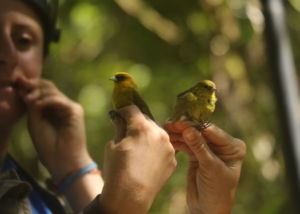“A Safe Harbor For ‘Akeke‘e – Operation Translocation” was selected by the Holohil Grant Review committee for the 2019 first quarter grant. Through this grant program, we received 12 LB-2X transmitters to attach to critically endangered ‘Akeke‘e. The goal of this project was to attach as many of the transmitters as possible to these elusive birds to better understand their ecology with the long-term goal of facilitating a successful translocation to another island with higher elevation than Kaua‘i. Such a translocation may be necessary to save this species from the threats of avian malaria and Rapid ‘Ōhi’a Death.
During the 2019 field season, we captured two young-of-the-year ‘Akeke’e. Transmitters were also attached to endangered ‘Akikiki, threatened ‘I’iwi, Kaua’i ʻAmakihi, and Kaua‘i ‘Elepaio to use as comparative data as these species (except ‘I’iwi) are thought to have smaller territories and dispersal compared to that of the ‘Akeke‘e. All birds were outfitted with the HoloHil LB-2X transmitters at a field site with eight omnidirectional telemetry towers that record signals 24/7 (in theory, at least! In practice all towers experienced down time due to solar panel issues). These towers fairly consistently surveyed area of approximately 50ha in core ‘Akeke’e habitat.
The movements captured by these towers using LB-2X transmitters will help inform the post breeding dispersal and habitat use of hatch year ‘Akeke‘e. Both transmittered ‘Akeke‘e were detected at two distinct tower locations for a brief amount of time the day of capture. No towers picked them up for the remainder of the two-week lifespan of the transmitters, indicating that the birds had left the study area. This behavior is not surprising for hatch year birds, who are likely looking for new territories.
While we did not receive much data from the transmittered ‘Akeke‘e, we did receive a lot of comparative information from the other species that we tagged. Most of these species were detected for longer periods of time. Further analysis of both transmittered ‘Akeke‘e and additional honeycreepers will be extremely valuable in determining not only the dispersal of young birds but the forest composition needed to facilitate the survival of these species. The data gathered will be used to help inform management and site selection for any possible translocation effort of the ‘Akeke‘e to additional Hawaiian islands.



